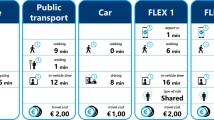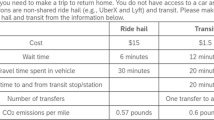Abstract
This paper reports the results of a 1998 survey carried out among a small sample of people who had called the TravInfo™ Travel Advisory Telephone System (TATS) in April 1997 looking for current information about traffic conditions in the San Francisco Bay Area. The survey employed a series of tradeoff questions designed to identify the specific attributes of the information that the respondents felt to be most important, and to estimate the relative values that these users had for various possible information improvements. Despite the small size of the sample, it proved feasible to investigate how the implicit valuations placed on each attribute of the service (update frequency, extent of road coverage, and level of customization) varied among different user segments. For the most part, respondents appeared to value basic enhancements – those that establish an initial quality differential above the baseline set by free broadcast traffic information – more than they value further subsequent improvements. Overall, more frequent information updates are the highest priority among the range of possible enhancements explored in the survey, followed by an extension of coverage to include major arterials in addition to freeways. However, the evidence suggests relatively little value in door-to-door coverage – that is, coverage of streets beyond the freeway and major arterial networks. This research produced some estimates of the average monetary values ("willingness to pay") that the sample of current users attached to information improvements of various kinds. While these values varied among subgroups in ways that fit a priori expectations, it is not clear whether they provide an unbiased picture of the users' absolute levels of willingness to pay, such that they could be used reliably to inform (for example) information pricing decisions. The value of this research lies more clearly in the light it sheds on the relative structure of user preferences, and on the variations in preferences between information attributes and market segments. Overall, the authors conclude that the prospects for self-sustaining ATIS services are unclear. In response to a direct question, a majority of users (perhaps influenced by a strategic bias) indicated that they were unwilling to pay for ATIS services; some of these same people, however, indicated later that they might indeed be willing to buy a particular enhanced ATIS package, in direct competition with free broadcast services.
Similar content being viewed by others
References
Abdel-Aty MA, Kitamura R, & Jovanis PP (1995) Investigating the effect of travel time variability on route choice using repeated-measurement stated preference data. Transportation Research Record 1493, 39-45.
Adler JL & McNally MG (1994) In-laboratory experiments to investigate driver behavior under advanced traveler information systems. Transportation Research 2C, 149-164.
Bregman S, Koses D, & Wilson AP (1997) Targeting the Car Phone Market: Findings from a Survey of Callers Using Cellular Telephones to Access the SmarTraveler(r) Advanced Traveler Information System, paper presented to the 76th Annual Meeting of the Transportation Research Board.
Charles River Associates Incorporated (1996) User Acceptance of ATIS Products and Services: What do we currently know?
Charles River Associates Incorporated (1997) User Acceptance of ATIS Products and Services: A report of qualitative research.
Charles River Associates Incorporated (1998) What ATIS Information Do Users Want? Evidence from in-vehicle navigation device users.
Crotty M & Goode R (1997) TravInfo™ gets traveler data from ‘whatever works'. Intellimotion 6(1), 8-9.
Englisher L, Bregman S, Pepin S, & Wilson AP (1997) Promoting advanced traveler information systems among cellular and land-line phone users: the SmarTraveler(r) experience in Boston. Transportation Research Record 1588, 63-69.
Kemp MA & Maxwell C (1993) Exploring a budget contest for contingent valuation estimates. In Hausman JA (ed), Contingent Valuation: A Critical Assessment, Amsterdam (Neth.): North-Holland, pp. 217-270.
Khattak AJ, Koppelman FR, & Schofer JS (1993) Stated preferences for investigating commuters’ diversion propensity. Transportation 20, 107-128.
Khattak AJ, Polydoropoulou A, & Ben-Akiva ME (1996) Modeling revealed and stated pretrip travel response to advanced traveler information systems. Transportation Research Record 1537, 46-54.
Lee D (2000) Benefit-Cost Evaluation of Traveler Information: Seattle's WSD. Forthcoming in the Transportation Reseach Record. Presented at the 79th Annual Meeting of theTransportation Research Board, January 2000.
Polydoropoulou A (1997) Modeling User Response to Advanced Traveler Information Systems, unpublished PhD thesis, Massachusetts Institute of Technology.
Polydoropoulou A, Gopinath DA, &Ben-Akiva M (1997) Willingness to pay for advanced traveler information systems: the SmarTraveler(r) case study. Transportation Research Record 1588, 1-9.
Reed TB & Underwood SE (1998), Choice Modeling as a Tool for Assessing the Market for Traveler Services, paper presented to the 8th Annual Meeting of ITS America.
Schofer JL, Koppelman FS, & Charlton WA (1997) Perspectives on driver preferences for dynamic route guidance systems. Transportation Research Record 1588, 26-31.
Select-phone CD-ROM, 1998 Edition - Pacific Region, Pro-CD Inc.
Statistical Abstract of the United States, 1997, Tables 247 and 717.
Wells K & Horan T (1999) Towards a Consumer Demand-driven ITS Policy: Findings from Southern California, paper presented to the 78th Annual Meeting of the Transportation Research Board.
Yim Y-B, Hall R, Koo R, & Miller M (1999) TravInfo™ 817-1717 Caller Study, paper presented to the 78th Annual Meeting of the Transportation Research Board.
Author information
Authors and Affiliations
Rights and permissions
About this article
Cite this article
Mehndiratta, S., Kemp, M., Pierce, S. et al. Users of a regional telephone-based traveler information system – a study of TravInfo™ users in the San Francisco Bay Area. Transportation 27, 391–417 (2000). https://doi.org/10.1023/A:1005261302077
Issue Date:
DOI: https://doi.org/10.1023/A:1005261302077




